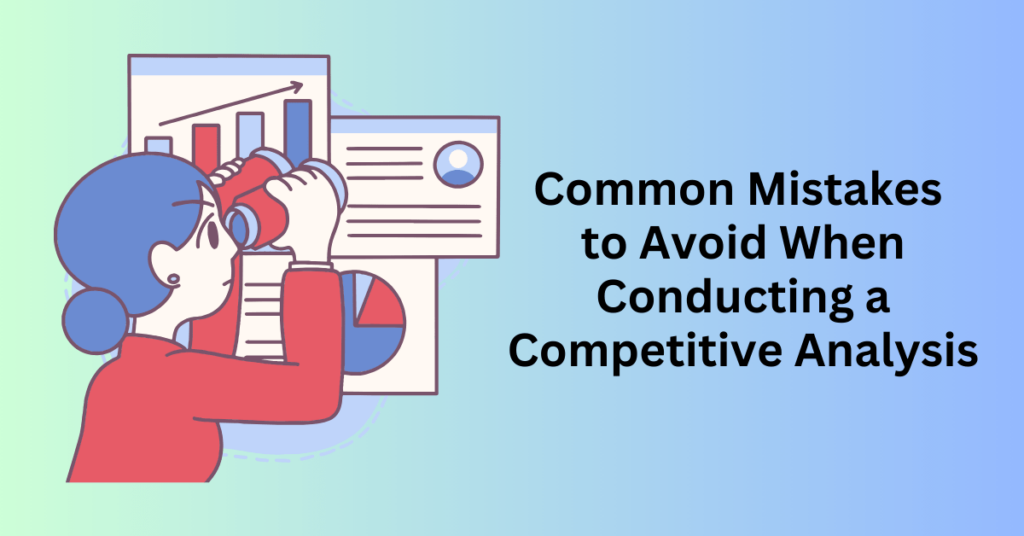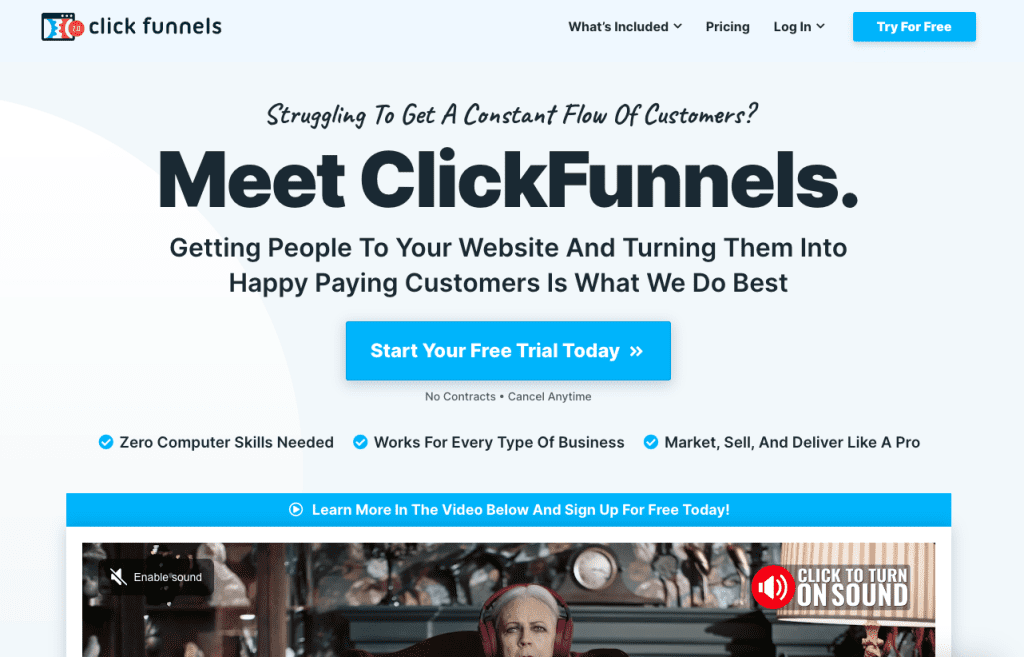When launching a new business, many entrepreneurs make the mistake of assuming that a product with no competition is a surefire path to success. However, in most cases, it doesn’t work that way. Having competitors is actually a good thing—it means there is market demand, your product is validated, and there are proven methods to sell it. So, how can you leverage this to your advantage and jumpstart your own business? The answer lies in competitive analysis. By studying your competitors, you can reverse-engineer their success and uncover strategies that work.
In this post, we’ll guide you through seven essential steps to conduct a competitive analysis. These steps will help you identify what’s working in your industry, and how you can deploy your own product or service for rapid growth.
Ready to dive in? Let’s get started!
Common Mistakes to Avoid When Conducting a Competitive Analysis

Many people mistakenly believe that a SWOT analysis (Strengths, Weaknesses, Opportunities, and Threats) is equivalent to a competitive analysis. While both are valuable tools for understanding the business landscape, they serve very different purposes.
A SWOT analysis focuses on evaluating your business within the market, whereas a competitive analysis digs deep into how your competitors operate, sell, and connect with your shared audience. To succeed, you need more than general assumptions about your competitors—you need clarity on their strategies.
Russell Brunson, in Expert Secrets, emphasizes this critical distinction. Competitive analysis isn’t about guessing your competitors’ strengths and weaknesses. Instead, it’s about uncovering exactly how they’re selling to your market and what strategies are working for them.
Brunson illustrates this concept with two eye-opening stories:
1. Misjudging the Buyer’s Ability to Pay
A friend of Russell’s attempted to break into the video game niche, which seemed like a goldmine at first glance. With millions of kids playing games, the potential audience appeared huge. But here’s the problem: kids don’t have credit cards. While the interest was there, the purchasing power wasn’t. Without an easy way to convert interest into sales, scaling the business was impossible. The mistake? Assuming the audience’s enthusiasm would naturally translate into revenue without considering their ability to pay.
2. Targeting the Wrong Mindset
Another entrepreneur, Joel Erway, aimed his coaching services at engineers—professionals with steady, high-paying jobs. From a financial standpoint, they could easily afford his offers. However, they weren’t interested in personal development. Engineers were not his ideal customers, and the market didn’t align with his product. After a year of struggle, Joel pivoted to a different audience—one that was already engaging with coaching programs—and his business took off. The lesson here? The right audience isn’t just able to pay; they must also be willing and ready to buy.
The Core Competitive Analysis Mistake
Both entrepreneurs stumbled because they made assumptions instead of thoroughly analyzing how their competitors succeeded. They didn’t dig into critical elements like:
- Who is actually buying?
- What price points work?
- How are competitors framing their offers?
- What marketing channels and messaging are effective?
By skipping these steps, they missed opportunities to align their strategies with market realities.
Besides, to ensure your competitive analysis is effective, go beyond surface-level observations. Focus on uncovering specific details such as:
- Pricing Models: How do competitors structure their offers? Is it subscription-based, one-time payments, or freemium?
- Payment Options: Are there barriers to entry, like limited payment methods?
- Purchase Behavior: Who is buying, and what motivates them?
- Messaging: What tone, language, or promises resonate with your target audience?
- Advertising Strategies: What platforms, ads, and tactics are driving their traffic?
By diving into these granular insights, you’ll gain a clear picture of what works in your industry and how you can stand out without wasting time or resources on avoidable mistakes.
Next, we’ll break down each of these elements in detail so you can conduct a thorough and actionable competitive analysis.
How to Conduct a Competitive Analysis in 5 Steps

Understanding your competition is essential to carving out a niche, refining your strategies, and successfully growing your business. Follow these five expanded steps to conduct a thorough competitive analysis and gain actionable insights.
Step 1: Identify 5-10 Competitors to Conduct a Competitive Analysis
Start by listing five to ten businesses that offer products or services similar to yours. This provides a manageable yet diverse pool for comparison. If your product or service is highly niche, finding direct competitors might be challenging. In that case, look beyond obvious rivals and consider indirect competitors or alternatives.
What to Do When Competitors Are Hard to Identify:
If you can’t pinpoint direct competitors, think creatively. For example, if you’re offering 1-to-1 coaching for SEO agency owners to improve their client onboarding process, direct competitors might be rare. Instead, examine:
- Books targeting SEO agency owners
- Online courses teaching SEO business operations
- Paid membership groups designed for SEO professionals
- Mastermind programs tailored for agency owners
This broader view ensures you still analyze businesses vying for your audience’s time, money, or attention, even if their offerings aren’t identical to yours.
How to Find Competitors:
Utilize tools and platforms designed for market research:
Google Search
Use keywords that are closely related to your product or service when conducting research. Pay special attention to phrases with “commercial intent,” such as “buy,” “best,” or “top-rated,” as these often lead you to businesses actively selling in your niche. Pro Tip: The businesses that rank on the first page for these relevant keywords are likely to be your strongest competitors, making them worth analyzing closely.
Google Ads
Examine the sponsored ads that appear alongside search results. Companies that run ads consistently often have profitable campaigns, which makes them valuable for studying and benchmarking. In addition, it’s important to keep an eye out for ads that show up repeatedly. These ads, in particular, suggest competitors who are heavily investing in proven, successful campaigns, highlighting opportunities for strategic insights.
Facebook Ads Library
Use the Facebook Ads Library to find ads currently running on Facebook and Instagram. By searching with industry-specific keywords and filtering for “Active” ads, you can uncover strategies that are performing well. Additionally, it’s useful to note that ads which have been running for a long time often indicate effective messaging and targeting. Therefore, these ads serve as great examples to learn from, offering valuable insights into what works.
Amazon (For Physical Products)
Explore Amazon’s Best Seller lists or browse relevant product categories to identify high-ranking items. Focus on products with numerous positive reviews, as these indicate popularity and strong demand. Moreover, customer reviews can be a goldmine for insights. They often reveal gaps or unmet needs in competitor offerings, which you can capitalize on to gain a competitive edge.
Social Media Platforms
Search for relevant hashtags, groups, and keywords on platforms like Instagram, Facebook, or X (formerly Twitter). By identifying accounts or influencers that align with your target audience and niche, you can discover potential collaboration opportunities. Additionally, prioritize competitors who have high engagement rates over those with just large follower counts. This is because engagement is a stronger indicator of audience interest and connection, providing more valuable insights into what resonates with your target market.
Step 2: Conduct Primary Market Research to Conduct a Competitive Analysis
Once you’ve identified your competitors, create a structured document or spreadsheet to organize your findings. As you analyze each competitor, you may realize some aren’t as relevant as you initially thought or uncover others that closely align with your business.
Key areas to focus on include:
1. Company Size
Evaluate the size of the competitor’s operation to gauge their market reach and strategy. A smaller company might indicate a focus on niche markets or a preference for lean business models. In contrast, larger organizations often possess substantial resources, making them tougher to compete against directly.
2. Target Market
Understand who the competitor is selling to. Are they targeting individuals, small businesses, or specific demographics? Identifying their audience can provide insights to help you refine your own customer profiles and ensure your marketing aligns with the right group.
3. Age of the Business
Consider how long the competitor has been in operation. Newer businesses might still be working to validate their market fit and establish credibility. On the other hand, more established competitors are likely to have proven strategies and a stable customer base.
4. Value Propositions
Analyze what makes the competitor’s offerings stand out. Look at the following aspects:
- Pain Points: What problems do they claim to solve for their customers?
- Desires: What outcomes or transformations do they promise?
- Benefits: What practical advantages do they emphasize?
- Social Proof: Pay attention to reviews, testimonials, or statistics they use to build trust with their audience.
5. Pricing Strategies
Examine their pricing approach to understand their market positioning. Are they competing based on price, value, or exclusivity? Note specific pricing structures, such as tiered plans, free trials, or discounts, to see how they attract and retain customers.
6. Revenue (If Available)
For public companies, review financial reports to gain insights into their revenue and overall market positioning. For private companies, you can estimate their success through indirect metrics, such as the volume and tone of online reviews, customer engagement levels, or visible ad spend.
Step 3: Secondary Market Research to Conduct a Competitive Analysis
Secondary market research is all about uncovering how your competitors attract traffic to their websites, sales funnels, and overall business. By leveraging the right tools, you can remove the guesswork and gain a comprehensive understanding of their strategies. This process not only reveals their strengths but also helps you identify areas where you can outperform them.
Understanding how competitors drive traffic gives you insights into which channels are most effective in your industry. Most businesses focus on just 2–3 primary traffic sources, and identifying these can streamline your efforts, saving time and resources.
Tools for Traffic Research
To thoroughly analyze your competitors’ traffic acquisition methods, consider using the following tools. While some offer free or freemium options, others require investment but provide invaluable insights:
- SimilarWeb: SimilarWeb provides a comprehensive overview of traffic sources, including organic search, paid search, social media, and referrals. This tool is ideal for understanding the percentage of traffic coming from each channel, enabling you to assess where your competitors are most active and successful.
- Ahrefs: Ahrefs specializes in organic search traffic and backlinks, offering insights into which competitor pages drive the most visits and rank highest on search engines. It’s especially useful for identifying content and SEO strategies that are performing well.
- SEMrush: SEMrush delivers detailed analyses of organic search, paid search, and display advertising campaigns. This tool is excellent for uncovering competitors’ keyword strategies and evaluating the performance of their ad campaigns, providing actionable insights for your marketing efforts.
- BuzzSumo: BuzzSumo focuses on analyzing social media traffic, highlighting the most shared content across platforms. It helps you understand which types of content resonate with audiences, making it easier to tailor your own social media strategy.
- Moz: Moz is primarily used for tracking SEO performance, allowing you to analyze organic search rankings and keyword performance. This tool helps you refine your own SEO efforts, giving you a competitive edge in search engine results.
Each of these tools offers unique insights that can help you evaluate your competitors’ strategies and enhance your own marketing approach.
What to Look For in Competitors’ Traffic Channels
1. Google Search
Use tools like Ahrefs or SEMrush to identify competitor pages that generate the most traffic through Google. Distinguish between two types of pages to better understand their strategy:
- Commercial Intent Pages: These are sales-oriented pages designed to drive conversions.
- Informational Intent Pages: These include blogs and guides aimed at attracting high-quality leads through valuable content.
Pro Tip: Pay attention to the balance between these page types to evaluate your competitors’ overall traffic strategy.
2. Google Ads
Analyze the pages attracting paid traffic through Google Ads campaigns. Competitors often use tools like ClickFunnels to funnel traffic from ads to optimized landing pages with high conversion potential.
Pro Tip: Look for signs of sophisticated funneling strategies to understand how competitors maximize their ad ROI.
3. Meta Ads (Facebook and Instagram)
Explore active competitor ads using the Facebook Ads Library. Navigate to their Facebook page, then go to About > Page Transparency > See All > Ad Library to view their campaigns.
Pro Tip: Focus on ads with long durations, as these often indicate profitability and effective messaging that resonates with the target audience.
4. YouTube
Identify YouTube channels linked to your competitors and analyze their most popular videos. Sort videos by view count to uncover those with disproportionately high engagement, as these may indicate paid YouTube ad campaigns.
Pro Tip: Save high-performing videos and explore links in their descriptions for potential sales funnels or promotional strategies.
5. Organic Social Media
Review competitors’ presence on platforms like Facebook, Instagram, and X (formerly Twitter). Look for posts with high engagement to gauge what content resonates with their audience.
Pro Tip: Investigate “link in bio” sections or the comments on posts to uncover how competitors direct traffic to their external pages, such as websites or landing pages.
6. Influencers and Affiliates
Many competitors collaborate with influencers or affiliates to drive traffic. Use tools like SimilarWeb to identify referral traffic sources and uncover influencers promoting competitor products.
Pro Tip: This can help you identify potential partners for your own campaigns or uncover gaps in your competitor’s influencer strategy.
7. Traditional Advertising
Some competitors may still rely on traditional advertising channels like TV, radio, or print. These campaigns can drive significant online interest.
Pro Tip: Use Ahrefs or SEMrush to monitor spikes in branded search traffic. Such spikes often correlate with offline campaigns that successfully increase brand visibility.
Actionable Insights from Competitors’ Traffic Acquisition
For each major traffic source, document:
- Ads: Specific advertisements driving traffic.
- Content: High-performing blog posts, videos, or guides.
- Sales Pages: Landing pages or product pages with significant traffic.
- Funnels: Any visible ClickFunnels or similar tools behind their strategy.
These details will become crucial as you proceed to analyze their sales processes in the next step. By systematically studying traffic channels, you’ll gain a clearer picture of what’s working in your industry and identify opportunities to outperform your competitors.
Step 4: Research the Sales Processes to Conduct a Competitive Analysis
Once you’ve identified how competitors drive traffic, the next step is to understand what they are selling and how they convert visitors into customers. By analyzing their sales processes, you’ll gain invaluable insights into the strategies they use to persuade, engage, and retain their customers.
Start by revisiting the traffic sources you discovered earlier. Focus on the pages that receive the most traffic and carefully analyze their purpose and design. Your goal is to identify how these pages contribute to driving sales and nurturing leads.
Types of Pages to Examine
Sales Pages: Sales pages are specifically designed to sell a particular product or service, often serving as standalone pages that are not directly linked to a website’s main navigation. These pages typically feature long-form content focused on a single offer, using persuasive techniques to drive conversions. Strategies like scarcity (e.g., “limited-time deal”) and urgency (e.g., “offer expires in 24 hours”) are commonly employed to create a sense of need. Additionally, sales pages usually include clear call-to-action (CTA) buttons such as “Buy Now” or “Claim Your Spot,” encouraging immediate action from visitors.
Product Pages: Product pages are standard eCommerce pages dedicated to showcasing individual products. These pages typically include detailed descriptions and high-quality images of the product, helping potential customers make informed purchase decisions. To build trust and increase credibility, product pages often feature customer reviews and ratings. Clear “Add to Cart” or “Buy Now” buttons are prominently displayed to facilitate easy purchasing, making these pages crucial in converting visitors into buyers.
Landing Pages: Landing pages are designed with the primary goal of collecting leads or guiding users through a sales funnel, rather than making an immediate sale. These pages usually offer valuable resources such as free guides, webinars, or consultations, which act as incentives for visitors to engage. Opt-in forms are commonly included for collecting email addresses, enabling future communication through newsletters or other freebies. To further entice visitors, landing pages often showcase testimonials or previews to generate interest in the offer and build credibility.
Next Steps: Diving Deeper Into Competitors’ Sales Funnels
1. Experience the Sales Process Firsthand
To truly understand a competitor’s strategy, it’s essential to immerse yourself in their customer journey. Here’s how:
- Sign Up for Newsletters or Free Offers:
- Many hidden sales pages, upsells, or cross-sells are only revealed after you engage with their lead magnets.
- Pay attention to email sequences, subject lines, and the timing of follow-ups.
- Make a Purchase:
- This step allows you to uncover their entire sales funnel, including pricing strategies, upsells, and guarantees.
- Evaluate the customer experience from payment processing to delivery or onboarding.
2. Analyze Their Offerings
When analyzing a competitor’s sales process, there are several key elements to document and evaluate:
Sales Processes:
The sales process refers to the sequence of steps that lead to a conversion. This might include initial actions like opt-ins or free trials, followed by upsells and other offers designed to maximize the customer’s lifetime value. Tools like Funnelytics can be helpful in visually mapping out the flow of these steps, allowing you to clearly understand the user journey and identify any gaps or opportunities for improvement.
Pricing Structures:
Examine the pricing structure of the competitor. Do they use tiered pricing, offering different levels of service or features at varying price points? Are there discounts for annual commitments to incentivize longer-term purchases? Additionally, assess how they justify their pricing, particularly if they charge a premium. Do they provide special features, exclusivity, or high-quality service that adds value, making the higher price more acceptable to customers?
Guarantees or Warranties:
Evaluate any guarantees or warranties the competitor offers to reduce buyer hesitation. This might include risk-free trials, money-back guarantees, or extended warranties. Such offerings can make customers feel more comfortable making a purchase, knowing they can get their money back or receive a replacement if the product doesn’t meet expectations.
Upsells and Cross-Sells:
Take note of any additional offers that are presented during or after the sale. Are they bundling products together to offer a discount or adding complementary items to increase the average order value? Do they have subscription services or other recurring revenue models that encourage customers to spend more over time? Understanding the upselling and cross-selling strategies can give insight into how they maximize revenue per customer.
Customer Support:
Test the quality of the competitor’s customer support channels, including chat, email, or phone support. Evaluate factors such as response times, the helpfulness of the support staff, and the overall ease of getting issues resolved. High-quality customer support can significantly impact customer satisfaction and retention, making it an essential area to assess when studying a competitor.
What You’ll Discover
By engaging directly with competitors’ sales processes, you can gain valuable insights into several key areas. First, you can uncover their conversion tactics, which reveal the specific promises, benefits, and pain points they emphasize to convert prospects into paying customers. Understanding these tactics helps identify what resonates with potential buyers and why they choose to make a purchase.
Additionally, you can assess their trust-building methods, such as the use of social proof in the form of testimonials, reviews, and case studies. These elements help establish credibility and reassure customers that their decision to purchase is well-founded.
Examining competitors’ retention strategies provides insight into how they nurture customer relationships post-sale. This may include follow-up emails, loyalty programs, or exclusive offers designed to keep customers engaged and encourage repeat business.
Finally, engaging with the sales process gives you a firsthand understanding of product quality, allowing you to evaluate the value provided by their product or service. This knowledge is crucial for identifying strengths and weaknesses in both your own offering and your competitors’ products.
How to Use This Information
- Identify Gaps: Pinpoint areas where your competitors may fall short (e.g., lack of strong guarantees or upsells).
- Improve Your Process: Adopt effective techniques that competitors are using while innovating to stand out.
- Validate Pricing: Ensure your pricing aligns with market expectations or find ways to justify higher rates through added value.
By dissecting your competitors’ sales processes, you’ll gain clarity on what works, what doesn’t, and how to position your business for success.
Step 5: How to Find a Red-Hot Market to Conduct a Competitive Analysis
The final step in your competitive analysis is identifying a thriving market where people are actively buying – and finding a unique niche within that market. By analyzing the landscape, you can position your product or service to meet untapped needs and solve problems better than competitors.
As Russell Brunson emphasizes:
“The goal is to carve out a unique spot in that ecosystem where you can thrive. That’s your niche. And that niche is one of the keys to success.”
Part 1: Listing Out Competitor Features
To identify where you can differentiate, start by creating a comprehensive overview of your competitors’ offerings. A structured document or Google Sheet works well to organize this information.
Key Elements to Track
Pricing Model:
When evaluating a product or service, it’s important to consider the pricing model—whether it involves one-time payments, subscriptions, freemiums, or tiered plans. Understanding these pricing strategies can reveal opportunities for offering more flexible or competitive models that appeal to a wider range of customers. Different pricing structures can also highlight areas where adjustments may increase sales or customer retention.
Price:
The base price of a product, along with any discounts, promotions, or free trials, is a key aspect to track. Understanding how these elements influence customer perceptions of value at specific price points is crucial for positioning your pricing effectively in the market. Moreover, by examining how price impacts demand, you can gain insights into customer behavior, allowing you to better tailor your offering to meet customer expectations. Ultimately, this helps enhance your sales potential and ensures your pricing strategy is aligned with market needs.
Function:
It’s essential to note the main problem that the product or service solves and how it promises to address that issue. Understanding the core function of the offering allows you to target overlooked problems or refine your approach to solvinIt’s essential to note the main problem that the product or service solves and how it promises to address that issue. By understanding the core function of the offering, you can identify overlooked problems or refine your approach to solving existing issues more effectively. In addition, this insight helps you cater to customer needs in a more targeted way, ultimately allowing you to stand out in a competitive market. Consequently, focusing on the core problem ensures your product remains relevant and valuable to your audience.g existing issues more effectively. This insight helps you cater to customer needs and stand out in a competitive market.
Features:
Pay attention to the specific features emphasized in sales pages, product descriptions, or marketing materials, as these often highlight what resonates most with customers. By doing so, you can identify potential gaps in the market that your competitors may not be addressing. Furthermore, understanding which features are valued enables you to better differentiate your offering or improve it to more effectively meet consumer expectations. As a result, this approach helps you refine your product and ensure it aligns with customer desires.
Target Market:
Track any mentions of customer demographics, industries, or personas in the marketing materials, as this information can provide valuable insights. By doing so, you can fine-tune your messaging to target segments of the market that may be overlooked or underrepresented. Moreover, a deep understanding of your target market enables you to create more effective and precise marketing campaigns. As a result, this leads to greater engagement and, ultimately, increased sales.
Style/Design:
Consider the aesthetic, branding, and overall visual style of the product or service, whether it’s modern, minimalist, bold, playful, or another approach. This differentiation in visual identity is crucial in a crowded market. By establishing a distinctive style, you can make your product stand out and appeal to specific customer tastes. Furthermore, a unique visual identity helps you build a strong brand presence, ensuring that your offering is easily recognizable and memorable in the marketplace.
Warranties/Guarantees:
Take note of any risk-reduction strategies such as money-back guarantees, free trials, or extended warranties. These assurances are often used to alleviate buyer hesitation, and incorporating similar strategies can work in your favour. Offering these guarantees not only builds trust but also reduces the perceived risk for customers, making them more likely to commit to a purchase.
Customer Support:
The availability and methods of customer support are also essential to track, whether it’s 24/7 availability, business hours, or self-service tools like FAQs or knowledge bases. Exceptional customer support can serve as a significant differentiator, particularly in service-oriented industries. Providing multiple support channels and a high level of service can enhance customer satisfaction and loyalty.
Part 2: Finding Market Gaps
Identifying gaps in competitors’ offerings is critical for carving out a profitable niche. The best way to do this is by listening directly to the voice of their customers.
Best Platforms to Explore Customer Feedback
Trustpilot:
Trustpilot is a valuable resource for gathering detailed feedback on eCommerce and SaaS products, as customers frequently leave in-depth reviews about their experiences. Therefore, when using Trustpilot, it is important to pay close attention to patterns in 2–4 star reviews. These reviews are particularly insightful because they often indicate that customers appreciate the product but believe there is room for improvement. By analyzing these reviews, you can identify specific areas where your offering may need refinement or adjustments, ultimately helping you meet customer expectations more effectively.
Google Reviews:
Google Reviews is particularly useful for receiving feedback on local businesses and service providers. It offers insights into customer experiences and satisfaction. When reviewing Google feedback, look for recurring themes around service quality, unmet expectations, or missing features. Identifying these trends can help you improve customer service and address gaps in your offerings.
Facebook Reviews:
Facebook Reviews are valuable because many businesses maintain active pages where customers leave feedback. These reviews often reflect real-time opinions from your audience, offering a direct window into their experiences. Therefore, it’s important to watch for common suggestions, complaints, or requests for additional features and services. By doing so, you can gain actionable insights into what your customers want or what they feel is lacking, enabling you to address their needs more effectively.
Social Media Comments/Mentions:
Social media comments and mentions offer a great way to hear directly from customers, as they often share their frustrations or desires through comments or tagged posts. Additionally, by tracking engagement trends on competitor posts or mentions of unmet needs, you can gain valuable insights into customer pain points, market demands, and areas where you can differentiate your brand or improve your product. This proactive approach helps you stay ahead of the curve and respond effectively to emerging trends.
Reddit Threads:
Reddit is a platform where customers often express unfiltered opinions and engage in honest discussions about products. In particular, threads on relevant subreddits can reveal customer struggles, requests for recommendations, or critiques of competitors. As a result, these discussions can uncover valuable insights into common issues or gaps that competitors are not addressing. By paying attention to these conversations, you can identify opportunities to improve or innovate your offering, positioning your brand as a solution to unmet needs.
Paid Groups, Memberships, and Forums:
Exclusive paid groups, memberships, and forums are ideal for in-depth conversations about customer needs. In these spaces, high-value discussions take place, where customers often share specific challenges, pain points, or feature requests that competitors haven’t yet addressed. By monitoring these forums, you can tap into a wealth of detailed feedback, which allows you to gain a deeper understanding of your target audience’s needs. Consequently, this information can help you refine your offering and stay ahead of the competition.
How to Use This Research
- Identify Recurring Gaps
- Look for repeated frustrations or unmet needs mentioned across multiple platforms.
- Example: If customers of a competitor’s product say the customer support is inadequate, you can position your brand with exceptional service.
- Spot Trends in Customer Desires
- Example: If multiple customers request a feature that competitors don’t offer, consider building it into your product.
- Refine Your Niche
- Use feedback to find overlooked demographics or underserved markets.
- Example: If competitors focus on young professionals, you might target retirees with similar needs.
- Validate Your Offering
- Use the insights to craft a unique value proposition, ensuring your product stands out in a red-hot market.
By systematically documenting competitor features and listening to customer feedback, you can uncover untapped opportunities and unmet needs. Focus on solving problems in a way that competitors can’t—or won’t—and you’ll carve out a profitable niche where your business can thrive.
How to Test Your Idea Fast?
Testing your business idea quickly and effectively is easier than ever with ClickFunnels. This platform allows you to set up funnels that help you test your ideas across different media with minimal effort. Whether you’re running Google Ads, Facebook campaigns, or leveraging organic traffic strategies, ClickFunnels enables you to direct visitors to professionally designed landing pages, sales pages, or opt-in forms—no coding or technical expertise is required.

Moreover, one of the most significant advantages of ClickFunnels is the ability to collect payments seamlessly. The platform integrates multiple payment options, including subscriptions, one-time offers, and upsells, giving you a flexible way to validate your idea. Consequently, the initial sales you generate act as crucial proof of your product or service’s potential, helping you confirm whether it resonates with your audience.
In this article, we’ve guided you through various steps to strengthen your idea validation process. Specifically, you learned how to analyze competitors’ strategies, conduct primary research to understand their businesses deeply, uncover their marketing tactics to drive traffic, and study their sales processes to understand how they convert customers. Additionally, we highlighted how to identify gaps in the market that allow you to position your product uniquely.
With ClickFunnels, you can take the insights gained from this research and put them into action. You can test your theories, refine your messaging, and ultimately build a business that thrives. Ready to take the next step? Try ClickFunnels today and start validating your idea the smart way.
Final Thoughts: 7 Proven Steps to Master Competitive Analysis
Competitive analysis isn’t just a one-time exercise; it’s an ongoing process that enables you to stay ahead in the dynamic world of business. By understanding your competitors’ strengths and weaknesses, you can carve out a unique position in the market and continually refine your strategies. The seven proven steps outlined in this blog—ranging from identifying competitors to leveraging your findings—provide a structured framework to gain actionable insights. Remember, the goal is not just to emulate your rivals but to learn from their successes and failures, ultimately crafting a strategy that aligns with your brand’s unique value proposition.
As you implement these steps, keep in mind that the business landscape is constantly evolving. Trends shift, customer expectations change, and new competitors emerge. Regularly revisiting your competitive analysis ensures you remain agile and responsive to these changes. With persistence and a commitment to staying informed, you’ll not only outsmart your rivals but also foster a deeper understanding of your industry. By prioritizing innovation and value creation, you position your business as a leader, ready to thrive no matter the challenges ahead.


